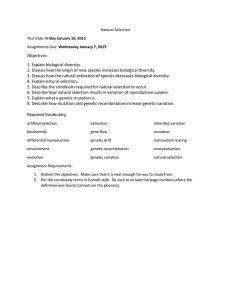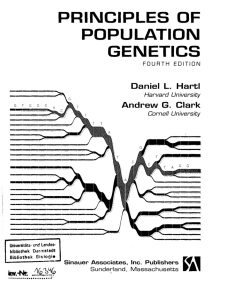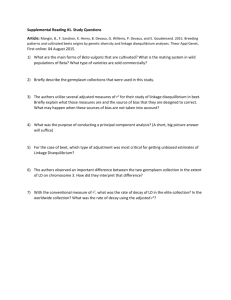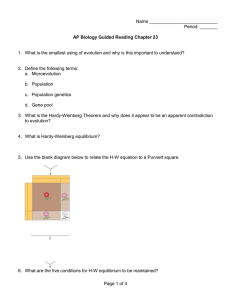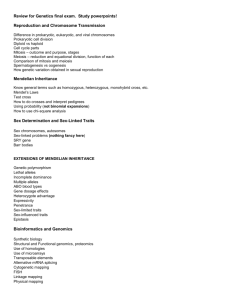Document 13999272
advertisement
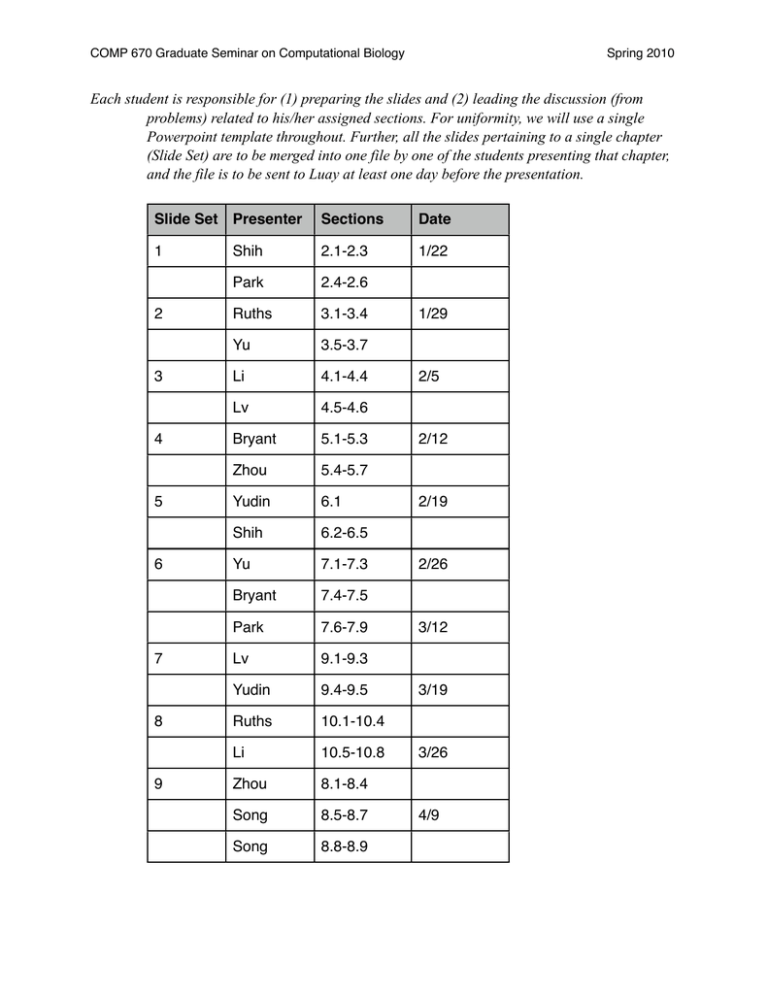
COMP 670 Graduate Seminar on Computational Biology Spring 2010 Each student is responsible for (1) preparing the slides and (2) leading the discussion (from problems) related to his/her assigned sections. For uniformity, we will use a single Powerpoint template throughout. Further, all the slides pertaining to a single chapter (Slide Set) are to be merged into one file by one of the students presenting that chapter, and the file is to be sent to Luay at least one day before the presentation. Slide Set Presenter Sections Date 1 Shih 2.1-2.3 1/22 Park 2.4-2.6 Ruths 3.1-3.4 Yu 3.5-3.7 Li 4.1-4.4 Lv 4.5-4.6 Bryant 5.1-5.3 Zhou 5.4-5.7 Yudin 6.1 Shih 6.2-6.5 Yu 7.1-7.3 Bryant 7.4-7.5 Park 7.6-7.9 Lv 9.1-9.3 Yudin 9.4-9.5 Ruths 10.1-10.4 Li 10.5-10.8 Zhou 8.1-8.4 Song 8.5-8.7 Song 8.8-8.9 2 3 4 5 6 7 8 9 1/29 2/5 2/12 2/19 2/26 3/12 3/19 3/26 4/9 COMP 670 Graduate Seminar on Computational Biology 1. Genetic and Phenotypic Variation • • • • • • • • Relevance of Population Genetics Phenotypic Variation in Natural Populations Continuous Variation: The Normal Distribution ◦ Mean and Variance ◦ The Central Limit Theorem ◦ Discrete Mendelian Variation ◦ Multiple-Factor Inheritance Maintenance of Genetic Variation Molecular Population Genetics Electrophoresis ◦ Allele Frequencies and Genotype Frequencies ◦ Polymorphism and Heterozygosity ◦ Allozyme Polymorphisms ◦ Inferences from Allozyme Polymorphisms ◦ Polymorphisms in DNA Sequences Restriction Enzymes ◦ The Polymerase Chain Reaction ◦ Single Nucleotide Polymorphisms ◦ Synonymous and Nonsynonymous Polymorphisms ◦ Segregating Sites and Nucleotide Mismatches ◦ Utility of Genetic Polymorphisms Summary 2. Organization of Genetic Variation • • • • • Random Mating Nonoverlapping Generations ◦ The Hardy-Weinberg Principle Random Mating of Genotypes versus Random Union of Gametes ◦ Implications of the Hardy-Weinberg Principle ◦ Testing for Hardy-Weinberg Equilibrium Difficulties in Testing for Hardy-Weinberg Equilibrium ◦ Complications of Dominance ◦ Frequency of Heterozygotes ◦ Extensions of the Hardy-Weinberg Principle Three or More Alleles ◦ X-Linked Genes ◦ Linkage and Linkage Disequilibrium Difficulties in Testing for Linkage Equilibrium ◦ Relative Measures of Linkage Disequilibrium: Dʹ′ and r2 ◦ Spring 2010 COMP 670 Graduate Seminar on Computational Biology • • Causes of Linkage Disequilibrium Linkage Disequilibrium Due to Population Admixture ◦ Linkage Disequilibrium Due to Reduced Recombination ◦ Summary 3. Random Genetic Drift • • • • • • • • Random Genetic Drift and Binomial Sampling The Wright-Fisher Model of Random Genetic Drift The Diffusion Approximation An Approach Looking Forward ◦ An Approach Looking Backward ◦ Absorption Time and Time to Fixation ◦ Random Drift in a Subdivided Population Effective Population Size Fluctuation in Population Size ◦ Unequal Sex Ratio, Sex Chromosomes, Organelle Genes ◦ Variance in Offspring Number ◦ Effective Size of a Subdivided Population ◦ Gene Trees and Coalescence Coalescent Effective Size ◦ Coalescence with Population Growth ◦ Coalescent Models with Mutation ◦ Applications of Coalescent Methods ◦ Theoretical Implications of Coalescence Coalescent Models with Recombination ◦ Linkage Disequilibrium Mapping ◦ Summary 4. Mutation and the Neutral Theory • • • • • Mutation Irreversible Mutation ◦ Reversible Mutation ◦ Mutation and Random Genetic Drift Probability of Fixation of a New Neutral Mutation ◦ The Neutral Theory of Molecular Evolution The Infinite-Alleles Model The Ewens Sampling Formula ◦ The Ewens-Watterson Test ◦ Infinite-Sites Model Nucleotide Polymorphism and Nucleotide Diversity ◦ Tajima’s D Statistic ◦ The Fu and Li Test of Fit to Neutral Coalescence ◦ Spring 2010 COMP 670 Graduate Seminar on Computational Biology • • Mutation and Recombination A Model for the Evolutionary Benefit of Recombination ◦ Muller’s Ratchet ◦ Piecewise Recombination in Bacteria ◦ Animal Mitochondrial DNA ◦ Summary 5. Darwinian Selection • • • • • • • Selection in Haploid Organisms Discrete Generations ◦ Continuous Time ◦ Change in Allele Frequency ◦ Darwinian Fitness and Malthusian Fitness ◦ Selection in Diploid Organisms Change in Allele Frequency in Diploids ◦ Marginal Fitness and Selection with Multiple Alleles ◦ Application to the Evolution of Insecticide Resistance ◦ Equilibria with Selection Overdominance ◦ Local Stability ◦ Heterozygote Inferiority ◦ Stable Equilibria with Multiple Alleles ◦ Adaptive Topography and the Role of Random Genetic Drift ◦ Mutation-Selection Balance Equilibrium Allele Frequencies ◦ The Haldane-Muller Principle ◦ More Complex Types of Selection Differential Selection in the Sexes ◦ X-linked Genes ◦ Frequency-Dependent Selection ◦ Density-Dependent Selection ◦ Fecundity Selection ◦ Age-Structured Populations ◦ Heterogeneous Environments and Clines ◦ Diversifying Selection ◦ Gametic Selection ◦ Meiotic Drive ◦ Multiple Loci and Gene Interaction: Epistasis ◦ Evolution of Recombination Rate ◦ Sexual Selection ◦ Kin Selection ◦ Interdeme Selection in Geographically Subdivided Populations Selection in a Finite Population Weak Selection and the Nearly Neutral Theory ◦ Spring 2010 COMP 670 Graduate Seminar on Computational Biology • Spring 2010 Genetic “Draft” ◦ Summary 6. Inbreeding, Population Subdivision, and Migration • • • • • • Inbreeding The Inbreeding Coefficient ◦ Genotype Frequencies with Inbreeding ◦ Genetic Effects of Inbreeding ◦ Calculation of the Inbreeding Coefficient from Pedigrees ◦ Regular Systems of Mating ◦ Population Subdivision Reduction in Heterozygosity Due to Population Subdivision ◦ Average Heterozygosity ◦ Wright’s F Statistics ◦ Linanthus Revisited: Evidence for Selection Associated with Flower Color ◦ Inference of Population Structure from Multilocus Genotype Data ◦ The Wahlund Principle Wahlund’s Principle and the Fixation Index ◦ Genotype Frequencies in Subdivided Populations ◦ Relation between the Inbreeding Coefficient and the F Statistics ◦ Assortative Mating Migration One-Way Migration ◦ The Island Model of Migration ◦ How Migration Limits Genetic Divergence ◦ Estimates of Migration Rates ◦ Coalescence-Based Estimates of Migration ◦ Migration-Selection Balance ◦ Summary 7. Molecular Population Genetics • • • • The Neutral Theory and Molecular Evolution Theoretical Principles of the Neutral Theory ◦ Estimating Rates of Molecular Sequence Divergence Rates of Amino Acid Replacement ◦ Rates of Nucleotide Substitution ◦ Statistical Fitting of Nucleotide Substitution Models ◦ The Molecular Clock Variation across Genes in the Rate of the Molecular Clock ◦ Variation across Lineages in Clock Rate ◦ The Generation-Time Effect ◦ The Overdispersed Molecular Clock and the Neutral Theory ◦ The Nearly Neutral Theory ◦ Patterns of Nucleotide and Amino Acid Substitution COMP 670 Graduate Seminar on Computational Biology • • • • • • Calculating Synonymous and Nonsynonymous Substitution Rates ◦ Codon Substitution Models ◦ Observations of Synonymous and Nonsynonymous Substitution Rates ◦ Polymorphism within Species ◦ Implications of Codon Usage Bias ◦ Polymorphism and Divergence in Nucleotide Sequence—The McDonald-Kreitman and HKA Tests Polymorphism and Divergence in Noncoding Sequences ◦ Impact of Local Recombination Rates ◦ Substitution Models for Structural RNA Genes ◦ Gene Genealogies Hypothesis Testing Using Trees ◦ Mitochondrial and Chloroplast DNA Evolution Chloroplast DNA and Organelle Transmission in Plants ◦ Maintenance of Variation in Organelle Genomes ◦ Evidence for Selection in mtDNA ◦ Molecular Phylogenetics Algorithms for Phylogenetic Tree Reconstruction ◦ Distance Methods versus Parsimony ◦ Bootstrapping and Statistical Confidence in a Tree ◦ Bayesian Methods ◦ Trans-Species Polymorphism ◦ Multigene Families Concerted Evolution ◦ Subfunctionalization ◦ Birth-and-Death Process ◦ Summary 8. Evolutionary Quantitative Genetics • • • • • • Spring 2010 Types of Quantitative Traits Resemblance between Relatives and the Concept of Heritability Artificial Selection and Realized Heritability Contribution of New Mutations to the Response to Selection ◦ Prediction Equation for Individual Selection ◦ Limits to Selection ◦ Genetic Models for Quantitative Traits Change in Allele Frequency ◦ Change in Mean Phenotype ◦ Linearity of Response ◦ Components of Phenotypic Variance Genetic and Environmental Sources of Variation ◦ Components of Genotypic Variation ◦ Covariance among Relatives Twin Studies and Inferences of Heritability in Humans ◦ COMP 670 Graduate Seminar on Computational Biology • • • • Spring 2010 Estimation of Genetic Variance Components in Natural Populations ◦ Norm of Reaction, Threshold Traits, and Genetic Correlation Norm of Reaction and Phenotypic Plasticity ◦ Threshold Traits: Genes as Risk Factors in Disease ◦ Genetic Correlation and Correlated Response ◦ Evolutionary Quantitative Genetics Inference of Selection from Phenotypic Data ◦ Evolution of Multiple Intercorrelated Traits ◦ Random Genetic Drift and Phenotypic Evolution ◦ Mutational Variance and Mutation–Accumulation Experiments ◦ Mutation-Selection Balance for Quantitative Traits ◦ Genes That Affect Quantitative Traits The Number of Genes Affecting Quantitative Traits ◦ Methods for Mapping QTLs ◦ Summary 9. Population Genomics • • • • • Evolution of Genome Size and Composition Organismic Complexity and the C-Value Paradox ◦ Base Composition of Genomic DNA ◦ Genome-Wide Patterns of Polymorphism Excess Polymorphism in Subtelomeric Regions ◦ Polymorphism and Rates of Recombination ◦ Hitchhiking versus Background Selection ◦ Linkage Disequilibrium and Haplotype Structures ◦ Decline of Linkage Disequilibrium with Genetic Distance ◦ Differences between Species Comparison of Nonsynonymous and Synonymous Divergence ◦ Positive Selection ◦ Exploiting a Phylogenetic Signal ◦ Polymorphism and Divergence ◦ Compensated Pathogenic Deviations ◦ Structure–Function Analysis ◦ Sexual Selection and the Sex Chromosomes Faster-Male Molecular Evolution ◦ Molecular Evolution of Genes in the X Chromosome ◦ Haldane’s Rule ◦ Demasculinization of the X Chomosome ◦ Transposable Elements Diverse Types of Transposable Elements ◦ Factors Controlling the Population Dynamics of Transposable Elements ◦ Insertion Sequences and Composite Transposons in Bacteria ◦ Transposable Elements in Eukaryotes ◦ Population Dynamics of Transposable Elements ◦ COMP 670 Graduate Seminar on Computational Biology • Nonuniformity of Transposition Rates ◦ Horizontal Transmission of Transposable Elements ◦ Summary 10. Human Population Genetics • • • • • • • • • Human Polymorphism Public SNP Resources and the HapMap Project ◦ Population Genetic Inferences from Human SNPs Ascertainment Bias of SNP Genotypes ◦ Departures from Hardy-Weingerg Frequencies ◦ Site Frequency Spectrum and Human Population Growth ◦ Rooting Human Polymorphism ◦ Inference of Inhomogeneities in the Mutation Process ◦ Inferences about Male and Female Mutation Rates ◦ Linkage Disequilibrium across the Human Genome The Landscape of Human Linkage Disequilibrium ◦ Inferences about Local Rates of Recombination ◦ Population Structure Inferred from Human Polymorphism Multilocus Methods of Inference of Stratification ◦ Heterogeneity in Linkage Disequilibrium across Human Populations ◦ Linkage Disequilibrium in Admixed Populations: Admixture Mapping ◦ Inbred Populations and Homozygosity Mapping ◦ Mendelian Disease and Population Genetics Mutation-Selection Balance ◦ Dating the Origin of Mutant Alleles ◦ Genetic Basis for Variation in Risk of Complex Disease Mapping Methods Based on Linkage ◦ Linkage Disequilibrium Mapping ◦ Genome-Wide Association Studies ◦ Seeking Signatures of Human-Specific Genetic Adaptations Interspecific Divergence ◦ McDonald-Kreitman and Poisson Random Field Tests ◦ Local Distortions in Linkage Disequilibrium ◦ FST Tests ◦ Genome Scans for Selection-Skewed Site Frequency Spectrum ◦ Human Origins Neanderthal Genome Sequence ◦ Summary Spring 2010
